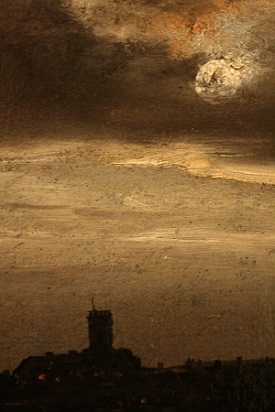 This course will investigate the representation of catastrophe by examining narratives of the plague pandemics, which collectively killed more than 200 million people. The goal will be to understand the strategies writers use to inform people of catastrophic risk — and specifically why those strategies succeed (or fail) to inspire action. Readings will include selections from Procopius’s History of the Wars, Boccaccio’s The Decameron, Hodges’ Loimologia, Defoe’s A Journal of the Plague Year, and other lesser-known accounts.
This course will investigate the representation of catastrophe by examining narratives of the plague pandemics, which collectively killed more than 200 million people. The goal will be to understand the strategies writers use to inform people of catastrophic risk — and specifically why those strategies succeed (or fail) to inspire action. Readings will include selections from Procopius’s History of the Wars, Boccaccio’s The Decameron, Hodges’ Loimologia, Defoe’s A Journal of the Plague Year, and other lesser-known accounts.
Meets: Saturday, February 1, 2014 – Saturday, March 8, 2014
10:00 AM to 12:00 PM at Richard Hugo House
General: $245.00
Members of Hugo House: $220.50
[mappress]
Click here for information on registration and financial aid.
Readings
Week 1 – Introduction to History of the Plague
- John Kelly, The Great Mortality (chapters 1-5)
Week 2 – Some Key Plague Narratives
- Procopius, History of the Wars (Book II, xxii-xxxiii) – 542 AD*
- Boccaccio, The Decameron (Introduction) – 1353 AD**
- Rosemary Horrox (trans. And ed.), The Black Death (various accounts) – 14th Century**
- Samuel Pepys, Samuel Pepys Diary (1665-1667) (http://www.pepys.info/1665/plague.html)*
- Nathaniel Hodges, Loimologia (sections I-III) – 1672 AD*
Week 3 – Daniel Defoe – A Journal of the Plague Year
- Daniel Defoe, A Journal of the Plague Year – 1722 AD*
Week 4 – Visions of End Times – Real and Imagined
- Clear and present threats: global warming, new pandemics, Malthusian catastrophe, mass extinction, genetic uniformity and crop blights, bioterrorism, supervolcanic eruptions, megatsunamis
- Damian Carrington, “Planet likely to warm by 4C by 2100, scientists warn” (http://www.theguardian.com/environment/2013/dec/31/planet-will-warm-4c-2100-climate)*
- Bellamy Pailthorp, “Sea Level Rise Map Shows 30 Wash. Towns Inundated” (http://www.kplu.org/post/sea-level-rise-map-shows-30-wash-towns-inundated)*
- Thomas Malthus, An Essay on the Principle of Population (Chapter 7) – 1798*
- Molly Billings, “The Influenza Pandemic of 1918” (http://virus.stanford.edu/uda/)*
- Martin Fackler, “Powerful Quake and Tsunami Devastate Northern Japan” (http://www.nytimes.com/2011/03/12/world/asia/12japan.html)*
- Edward Ortiz, “Bioterrorism concerns keep genetic code for new strain of botulism under wraps” (http://www.fresnobee.com/2013/12/18/3674754/bioterrorism-concerns-keep-genetic.html)*
- University of California Berkeley’s Understanding Evolution website, “Monoculture and the Irish Potato Famine: cases of missing genetic variation” (http://evolution.berkeley.edu/evolibrary/article/agriculture_02)*
- Rebecca Morelle, “Yellowstone supervolcano ‘even more colossal’” (http://www.bbc.co.uk/news/science-environment-25312674)*
- Jim Galasyn, “50 doomiest graphs of 2013” – December 31, 2013 (http://www.desdemonadespair.net/2013/12/50-doomiest-graphs-of-2013.html)*
- Distant and imagined threats: black holes, impact events (asteroids), decline in atmospheric oxygen, experimental accidents (e.g., high-energy physics), technological singularity, extraterrestrial invasion, zombie apocalypse
- Eben Harrell, “Collider Triggers End-of-World Fears” (http://content.time.com/time/health/article/0,8599,1838947,00.html)*
- Phil Plait, “NASA’s Wise Asteroid Hunter Back in Business” (http://www.slate.com/blogs/bad_astronomy/2013/12/20/neowise_nasa_s_asteroid_hunter_is_back_in_business.html)*
- Peter Tatchell, “The oxygen crisis” (http://www.theguardian.com/commentisfree/2008/aug/13/carbonemissions.climatechange)*
- Fay Schlesinger, “Stephen Hawking: Earth could be at risk of an invasion by aliens living in ‘massive ships’” (http://www.dailymail.co.uk/sciencetech/article-1268712/Stephen-Hawking-Aliens-living-massive-ships-invade-Earth.html)*
- Ben Popper, “Rapture of the nerds: will the Singularity turn us into gods or end the human race?” (http://www.theverge.com/2012/10/22/3535518/singularity-rapture-of-the-nerds-gods-end-human-race)*
- David Wong, “5 Scientific Reasons a Zombie Apocalypse Could Actually Happen” (http://www.cracked.com/article_15643_5-scientific-reasons-zombie-apocalypse-could-actually-happen.html)*
- Linear religious eschatology
- Judaic: various books of the Hebrew Bible – dating back to the 10th century AD (summary)
- Christian: Book of Revelation (King James Bible) – 95 AD*
- Zoroastrian (Persian): Bahman Yasht (or Zand of the Vohuman Yast) – 6th century AD (read summary)*
- Islamic: Sūrat al-Qiyāma (75th chapter of the Quran) – 7th century AD
Week 5 – Risk Perception and Coping Mechanisms
- Albert Camus, The Plague
- William S. Burroughs, “Twilight’s Last Gleamings” (from The Paris Review, No. 109, Winter 1988)**
- Kristin Jackson, “Exploring the tragic beauty of Hawaii’s remote Kalaupapa” (http://seattletimes.com/html/travel/2020308049_kalaupapahawaiixml.html)*
- David Quammen, “Anticipating the Next Pandemic” (http://www.nytimes.com/2012/09/23/opinion/sunday/anticipating-the-next-pandemic.html?pagewanted=all)*
- Anthony Costello et al, “Global health and climate change: moving from denial and catastrophic fatalism to positive action” (http://rsta.royalsocietypublishing.org/content/369/1942/1866.full)*
- Coral Davenport, “The Coming GOP Civil War Over Climate Change” (http://www.nationaljournal.com/magazine/the-coming-gop-civil-war-over-climate-change-20130509)*
- Helen Thomson, “Japanese fatalistic about risk of death from earthquake” (http://www.newscientist.com/article/dn20267-japanese-fatalistic-about-risk-of-death-from-earthquake.html)*
- Kenneth Worthy, “Despair, Courage, & Hope in an Age of Environmental Turmoil” (http://www.psychologytoday.com/blog/the-green-mind/201311/despair-courage-hope-in-age-environmental-turmoil)*
- James Wesley Rawles, How to Survive the End of the World as We Know It: Tactics, Techniques, and Technologies for Uncertain Times (chapter 1, “The Survival Mind-set for Living in Uncertain Times”)**
- Michel Foucault, Madness and Civilization (chapters 1-2)**
- Emily Matchar, “Boom Times” (http://www.outsideonline.com/outdoor-adventure/outdoor-skills/survival/Boom-Times-20120801.html)*
- Alan Feuer, “The Preppers Next Door” (http://www.nytimes.com/2013/01/27/nyregion/the-doomsday-preppers-of-new-york.html?_r=0)*
- Richard Morgan, “Life After Earth: Imagining Survival Beyond This Terra Firma” (http://www.nytimes.com/2006/08/01/science/01arc.html)*
- Roger Highfield, “Colonies in space may be only hope, says Hawking” (http://www.telegraph.co.uk/news/uknews/1359562/Colonies-in-space-may-be-only-hope-says-Hawking.html)*
- Margaret Hartmann, “The ‘End Times’ Are Upon Us, According to Michele Bachmann” (http://nymag.com/daily/intelligencer/2013/10/end-times-bachmann.html)*
Week 6 – Understanding Resistance and Inspiring Action
- Stephan Dickert and Paul Slovic, “Unstable values in lifesaving decisions” (http://www.frontiersin.org/cognition/10.3389/fpsyg.2011.00294/full)*
- Paul Slovic et al, “Insensitivity to the Value of Human Life” (http://www.researchgate.net/publication/227004861_Insensitivity_to_the_Value_of_Human_Life_A_Study_of_Psychophysical_Numbing/file/50463529ac0c0cac90.pdf)*
- George Marshall, “Why We Find It So Hard to Act Against Climate Change” (http://www.yesmagazine.org/issues/climate-action/why-we-find-it-so-hard-to-act-against-climate-change)*
- Dan Gilbert, “If only gay sex caused global warming” (http://articles.latimes.com/2006/jul/02/opinion/op-gilbert2)*
- Fiza Salim, “Culture, Politics, and Religion: Exploring Resistance to Vaccinations in South Asia” (http://www.academia.edu/3158834/Culture_Politics_and_Religion_Exploring_Resistance_to_Vaccinations_in_South_Asia)*
- Kharunya Paramaguru, “The Battle Over Global Warming Is All in Your Head” (http://science.time.com/2013/08/19/in-denial-about-the-climate-the-psychological-battle-over-global-warming)*
- Dan M. Kahan et al, “The Tragedy of the Risk-Perception Commons: Culture Conflict, Rationality Conflict, and Climate Change” (http://papers.ssrn.com/sol3/Delivery.cfm/SSRN_ID1871503_code45442.pdf?abstractid=1871503&mirid=5)*
- Richard Posner, Catastrophe: Risk and Response (chapter 2, “Why so little is being done about the catastrophic risks”)**
- United Nations Educational, Scientific and Cultural Organization (UNESCO), “World Social Science Report: Changing global environments” (http://unesdoc.unesco.org/images/0022/002233/223388e.pdf)*
- Adam Corner, “Why the World Won’t Listen” (http://www.slate.com/articles/health_and_science/new_scientist/2013/09/ipcc_climate_change_denial_psychology_and_human_nature_trump_science_and.html)*
- Al Gore, “Climate of Denial: Can science and the truth withstand the merchants of poison?” (http://www.rollingstone.com/politics/news/climate-of-denial-20110622)*
*Available online
**Will be included in course reader